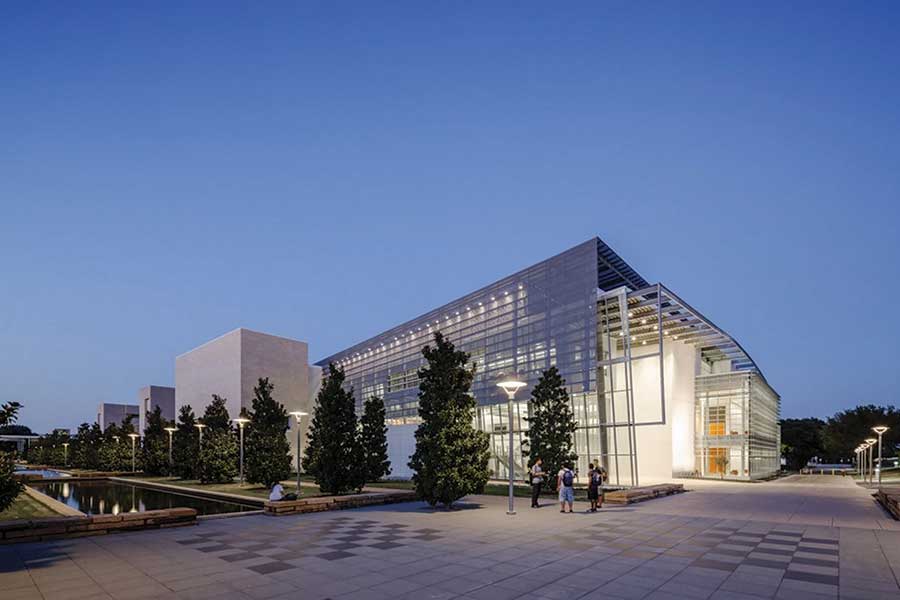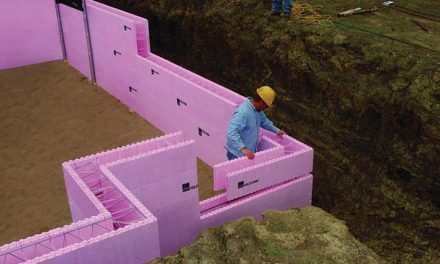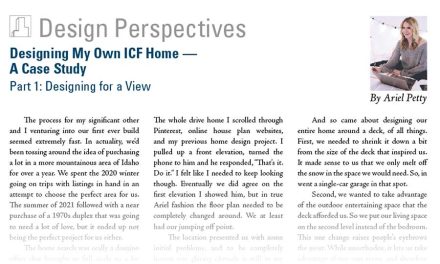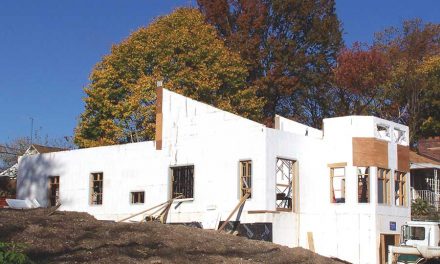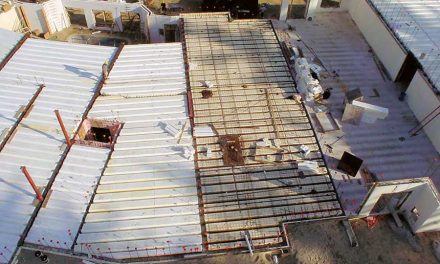The Edith O’Donnell Arts & Technology Building at the University of Texas, Dallas, uses a partially exposed concrete structure to take advantage of concrete’s thermal mass properties which trap heat during cold months and keep structures cooler during warmer weather.
By Vanessa Salvia
Concrete gets a bad rap. In 2019, the Guardian published an article titled “Concrete: the most destructive material on Earth.” It’s true that concrete is the most-used material on earth after water. It’s true that concrete is responsible for about 8% of global carbon emissions. But there are so many other reasons why building with concrete is better. And, the industry is on a roadmap to carbon neutrality by 2050.
The challenge for concrete is that its key ingredient, cement, is responsible for most of the emissions from concrete. One important measure is embodied carbon. Embodied carbon is a measure of all the CO2 emitted in producing materials, from extract to processing. An article in the Journal of Industrial Ecology stated that a 15-story reinforced concrete apartment building in Atlanta, Georgia, gave an embodied carbon value of 233 kilograms of carbon dioxide equivalents per square meter. A timber building of similar size contained considerably less embodied carbon.
The concrete industry understands the urgency in reducing its carbon footprint. In 2021, the National Ready Mixed Concrete Association (NRMCA) adopted a goal of reducing the carbon footprint of concrete by 50% by 2030, and then 100% reduction by 2050. The NRMCA recently reported that its members have shown a 21% decrease in carbon footprint on average from the 2014 benchmark (see this issue’s News story).
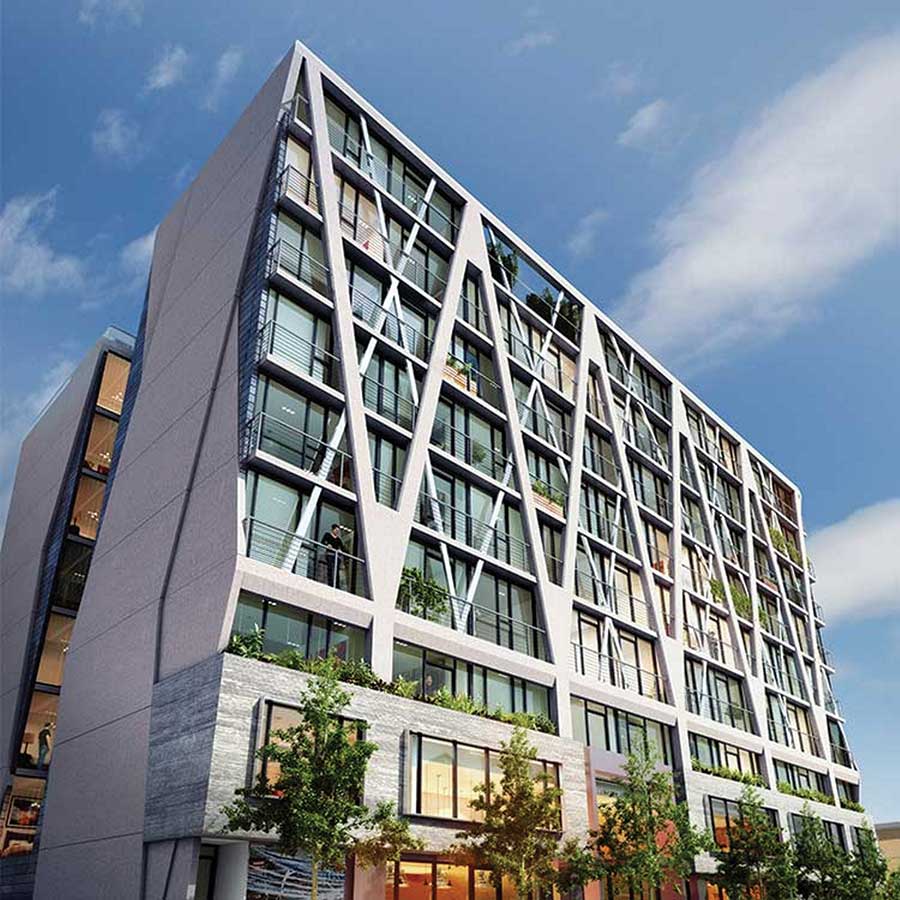
One of San Francisco’s newest and sleekest residential structures, the Rowan, uses a giant, zigzagging concrete exoskeleton and stands out from other buildings. Concrete on the project used high volumes of fly ash to reduce environmental footprint.
“We’re on the path towards that 50% reduction by 2030,” says Lionel Lemay, executive vice president of structures and sustainability for NRMCA, “but I think the reductions are going to become more difficult to achieve now.”
The combination of innovative cements that use limestone and supplementary cementitious materials, like fly ash and slag, help optimize the use of portland cement, which has a relatively high carbon footprint. “If you can optimize the mix designs, then you can get all of the benefits of concrete at a lower carbon footprint,” Lemay says.
Doubling the World’s Building Stock
According to a 2017 Global Status Report from the United Nations Environment and International Energy Agency UN Environment, 2017, the world is projected to add 230 billion square meters (2.5 trillion square feet) of buildings by 2060. That will double the entire current global building stock.
The Global Cement and Concrete Association, European Committee for Concrete and the Portland Cement Association in North America have all developed a plan to reduce embodied carbon in concrete by 40 to 50% by 2030 and to reach carbon neutrality by 2050. The Carbon Leadership Forum, part of the World Resources Institute (WRI), developed a paper to explore the idea of setting a low-carbon cement standard in the United States in which businesses would use tradable credits in which cement producers and importers would generate or surrender credits based on their performance against an emissions intensity benchmark. These credits would reward companies that reduce emissions. To be clear, this is a proposal, not a plan, but whether you are a concrete producer or a contractor, the topic of reducing concrete’s carbon footprint will affect you in some way in the near future.
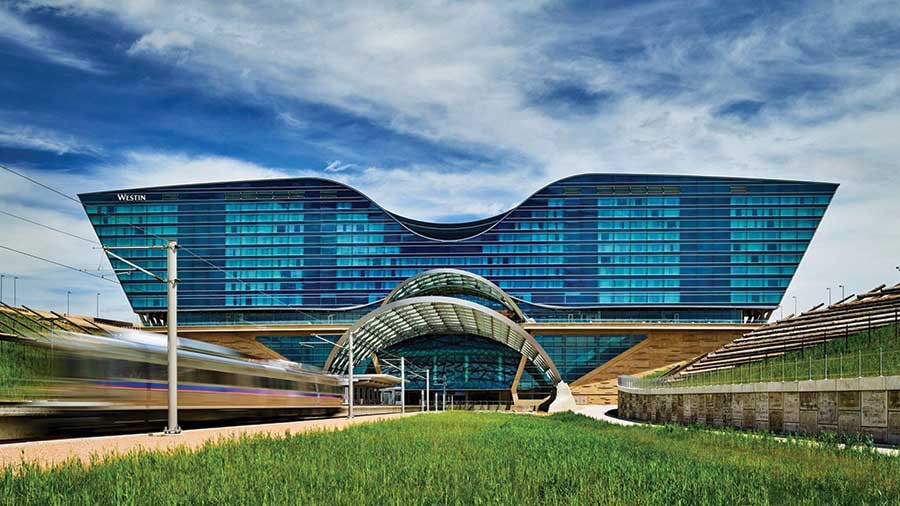
The Denver International Hotel & Transit Center in Denver, Colorado, used complex mix designs including high strength, self-consolidating, and lightweight concrete for the transit and hotel canopy abutments, the hotel ballroom’s transfer beams and slab, and the structure’s sloping roof deck.
“Most people in the industry would rather not be regulated,” says Lemay. “But it can be a good thing such as in the auto industry that has helped develop lower mileage cars out of necessity. There’s probably a good combination of regulation and legislation that can create some standards.”
LEED credits, which many people in the industry already adhere to, is an example of how regulation and a credit exchange could potentially work. If you can show that your project is below a certain industry benchmark, then you’ll get a credit, for example.
“When people build buildings they want something that’s durable, energy efficient, and quiet,” says Lemay. “These are performance-oriented requirements that an owner wants. But now we have this other criteria, which is embodied carbon. Making a building resilient and energy efficient helps drive down the operational carbon emissions of buildings, but materials themselves do contribute significantly to carbon emissions. And so if we can offer all of those benefits that owners and architects and engineers want at a lower carbon footprint then we should.”
Alternative Ingredients & Mixes
Many companies and research labs are experimenting with new ways to manufacture concrete and new mixtures and additives to make it more green. Central Concrete, in San Jose, California, for instance, is using CarbonCure technology to inject carbon dioxide into the concrete to lock that greenhouse gas into the concrete and keep it out of the atmosphere. The extra carbon dioxide also has the benefits of strengthening the concrete and reducing the amount of cement needed. LinkedIn is using this “CarbonCure technology” for its 245,000-square-foot headquarters the company is building in Mountain View, California.
The most common way to green up concrete is to supplement cement with other materials that enhance concrete’s performance. According to the NRMCA, 370 million cubic yards of concrete was produced last year, in the United States alone. Nearly 40% was used on commercial real estate projects. The use of concrete is not likely to decline any time soon, so the best option is not to stop using it or use less of it, but to make it better however possible. Another important piece of the puzzle is to recycle concrete and reuse it whenever possible. This helps reduce the need to create new concrete and use up all the resources that go into producing it.
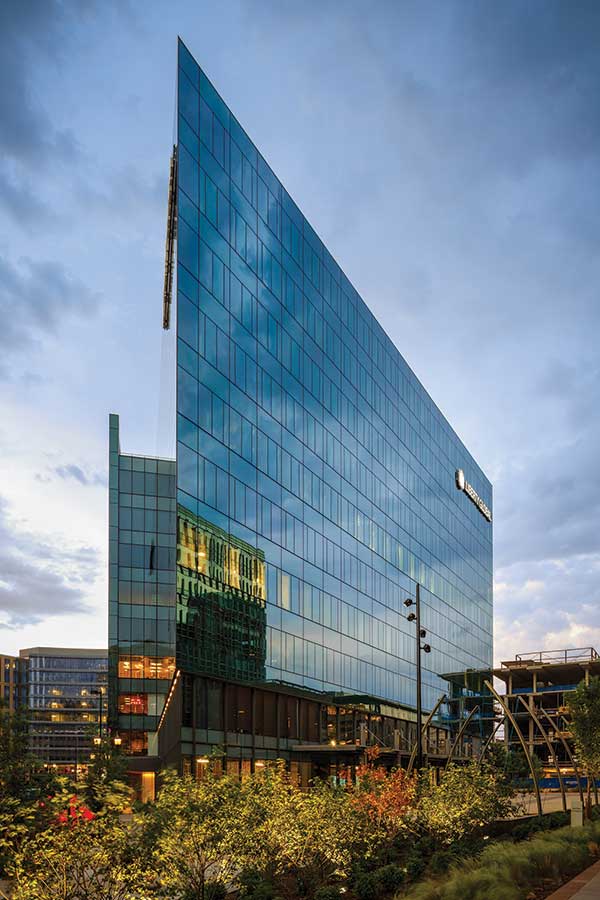
The Triangle Building in Denver used 15 types of concrete including shotcrete, cast-in-place, high strength and lightweight concrete. Each variety serves a particular purpose and contributes to the building’s LEED Gold Certification.
Cement is about 10% of the concrete mix. To manufacture cement, limestone, clay, and sand are heated in extremely hot ovens to form a substance known as clinker. This material is then mixed with limestone and other additives such as pozzolan. Producing the clinker is the process that creates the most carbon dioxide emissions — approximately 815 kilograms of CO2 for every 1,000 kilograms of clinker manufactured, according to a 2019 article by Robbie M. Andrew in the journal Earth System Science Data.
However, concrete naturally absorbs from the atmosphere over time in a process called carbonation. In carbonation, a chemical reaction occurs between carbon dioxide in the air and calcium hydroxide and hydrated calcium silicate in the concrete to form carbonates. This leads to a permanent sequestration of this CO2. There are ways being developed now to accelerate that process, which would help remove more carbon from the atmosphere.
Advantages of Concrete
We in the ICF industry already know that concrete is wallet-friendly. It’s also the safest. It lasts longer than any other building material. It resists pests and fires. It is sturdier in the face of natural disasters. Often, it is locally sourced, which means it can come from ingredients and suppliers near the project site. It is recyclable. It is versatile. It is highly energy efficient thanks to its high thermal mass. A 2019 study by the International Institute for Sustainable Development (https://www.iisd.org/publications/emission-omissions) indicated that concrete buildings have a significantly smaller carbon footprint than those built with wood.
The NRMCA’s Build With Strength coalition puts a lot of emphasis on proper mix design to reduce concrete’s carbon footprint. Combining some of the portland cement with supplementary cementitious materials (SCMs) such as the waste byproducts slag cement and fly ash can help. Currently, SCM use may be limited in traditionally formed concrete, but can be higher in ICFs because of the ideal curing conditions. Fly ash and slag are less abundant now than they used to be due to changes in steel production and coal plants being retired. But, the industry is working to develop other sources of SCMs, such as pozzolan made from recycled post-consumer glass. Lemay indicates that fly ash distributors predict that about 100 years worth of fly ash is buried in landfills, which some companies are now harvesting for use in concrete..
“If somebody says they want to reduce the carbon footprint by 50% today on a project, they can do it,” says Lemay. “But the obstacle is that you can’t do it on every project because there’s just not enough material like fly ash and slag and the optimized blended cements.”
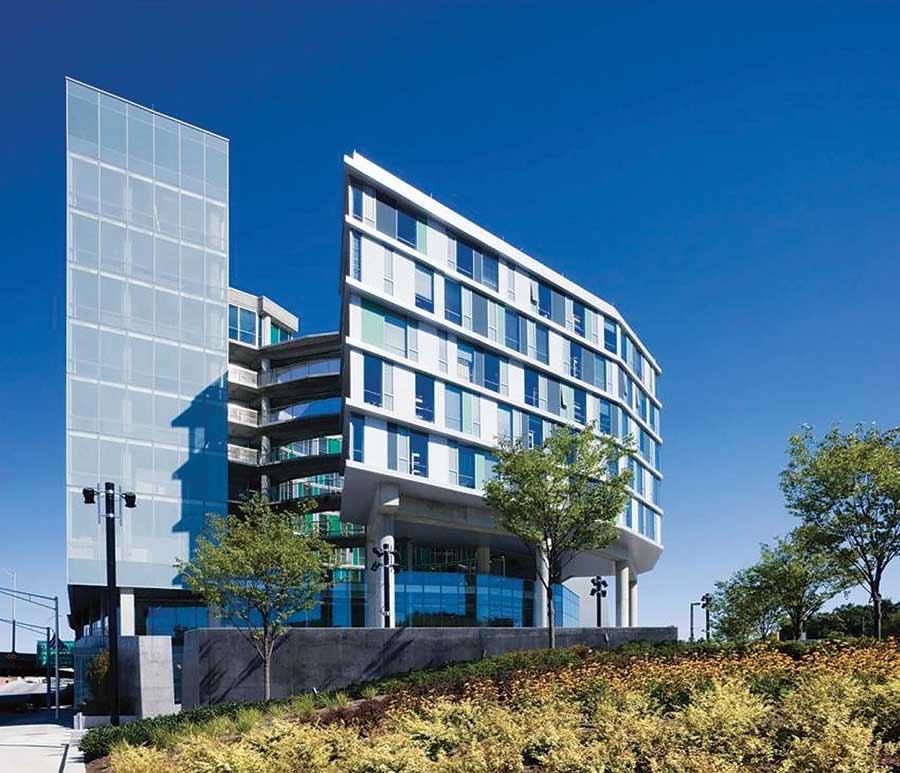
The Gateway at the Maryland Institute College of Art in Baltimore uses concrete to form distinctive circular structures sectioned into three pods of residential units surrounding a private central courtyard. The flexibility of concrete is on full display in the drum shape of the residential wing. Concrete structural slabs create the support the building needed to achieve its unique design.
Responding to the pressure
Blue Planet, based in Los Gatos, California, is working on a pilot program to use carbon dioxide collected from the exhaust stack of a power plant to produce a synthetic limestone that can replace sand and gravel in concrete. Other companies are working on their own formulations. Hempcrete, which uses the woody stalks of the hemp plant mixed with a lime-based binder instead of cement, can function as a concrete replacement for many applications that don’t require a high degree of compressive strength. It’s likely to require a variety of solutions to provide alternatives to cement, alternatives to concrete, and greener concrete in general.
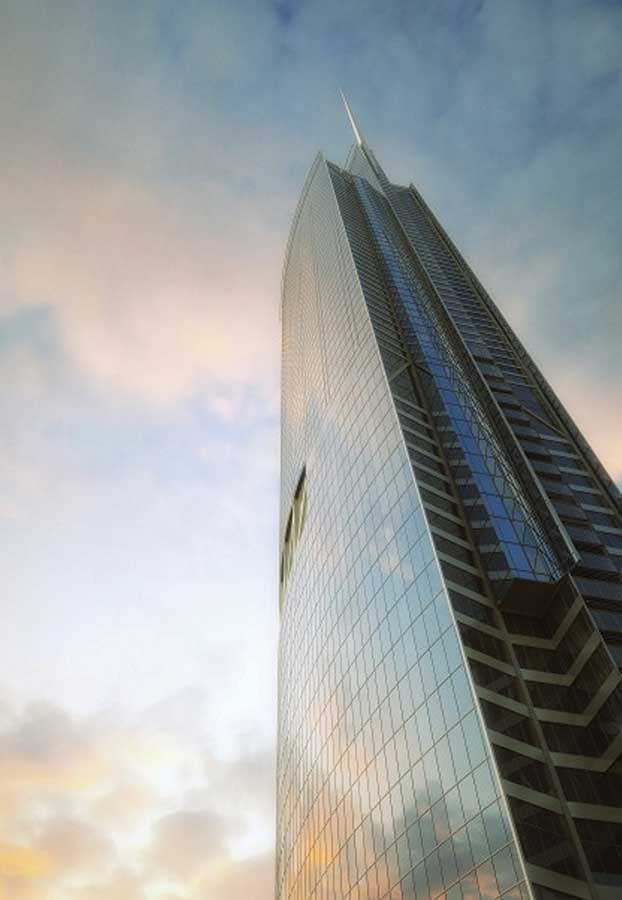
Standing at 1,100 feet tall, the Wilshire Grand Center in Los Angeles is the tallest building west of the Mississippi. The building uses a mixed concrete and steel structural system consisting of composite concrete and steel floors that span from an internal concrete core to perimeter concrete-filled steel box columns.
Contractors who work with concrete are on the front lines of an industry that is responding to pressures from climate change and an increasing need for more, higher performing, and safer buildings. If you can, consider the impact of your choices when mixing your own concrete or purchasing it from a producer. An efficient mix made for the job at hand is one of the decisions that will have the most significant impacts on concrete’s carbon footprint.
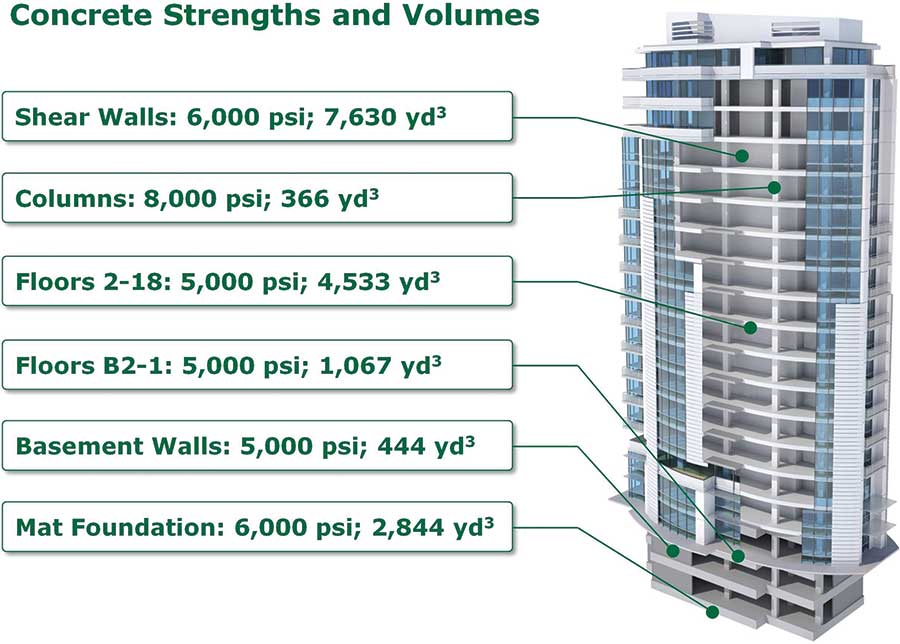
Specified compressive strength of concrete for an 18-story residential tower.
Lemay says the technology exists to create a zero carbon concrete. But, they wouldn’t be able to make enough of it to meet the demand. That the technology exists, though, is encouraging to Lemay. Lemay says project specifications can often be contradictory in that the specs will call for a low-carbon concrete but will also place limits on the other materials that can be used in the mix. “What we try to say,” explains Lemay, “is that we can help you write a spec that meets all your performance needs for strength, durability, fire resistance, whatever the case, and we will help you write the portion that says you want a lower carbon footprint and establish what that footprint is.”
Understanding Embodied Carbon & Why It Matters
Embodied carbon refers to how much CO2 (greenhouse gas emissions) is emitted from a building or structure over its complete lifecycle. It includes all the CO2 emitted from extracting materials, manufacturing, transporting, and placing the material. It also includes CO2 emissions during maintenance, demolition, or decommissioning. A separate measure called operational carbon measures the CO2 generated from the fossil fuels that are used for power for the building: lighting, heating, cooling, etc. It is possible to reduce operational carbon with updates in efficiency after the building is constructed, but it is not possible to decrease embodied carbon once the building is constructed.
According to Carbon Cure, which manufactures technologies to add captured carbon dioxide into concrete during the production process, embodied carbon is expected to account for nearly 50% of the overall carbon footprint of new construction between now and 2050. Achieving the goal of 40 to 50% reduction by 2030 requires that concrete contractors produce or purchase lower-carbon concrete. If you’re not motivated by the green aspect, consider that using more efficient concrete mixes can save you money.
Since embodied concrete takes into account every aspect of a building’s life, you can reduce the overall impact by running a fuel-efficient concrete program in whatever way you can. Efficient scheduling and dispatch all means less fuel used. Avoid trucks idling. Eliminate waste concrete. Recycle and reclaim aggregate and water. Specify or use concrete made with alternative binders such as fly ash and slag if you can.

